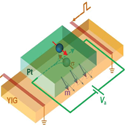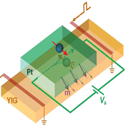Electrons Churn Up Spin Waves
A spin wave propagates through a ferromagnet when the spins precess around an applied magnetic field in a progressive way—the spin at each location in the lattice is slightly ahead of the one next to it. Researchers have high hopes for using them in devices, but the waves tend to damp out rapidly, thanks to scattering on defects and other effects. One way to amplify spin waves and counter damping uses microwaves, but it only works in a narrow frequency range and requires a microwave source. In a paper in Physical Review Letters, Zihui Wang of Colorado State University in Fort Collins and colleagues introduce another way to amplify spin waves using only a nearby electric current.
The team sent -nanosecond-long spin wave pulses horizontally through a -micrometer-thick yttrium iron garnet (YIG) film “capped” with a -nanometer-thick layer of platinum. During each spin wave pulse, they applied a dc voltage pulse to the platinum layer above, which, thanks to the spin Hall effect, generated a current of spin-polarized electrons moving downward toward the YIG film. These polarized electrons scattered off the YIG and donated some of their angular momentum to the spin waves.
The team showed that they could boost or attenuate the spin wave amplitude by up to , depending on the amplitude and polarity of the dc voltage. They now hope to dramatically increase the amplification by using larger dc voltages in a way that doesn’t interfere with the spin waves. – David Ehrenstein





